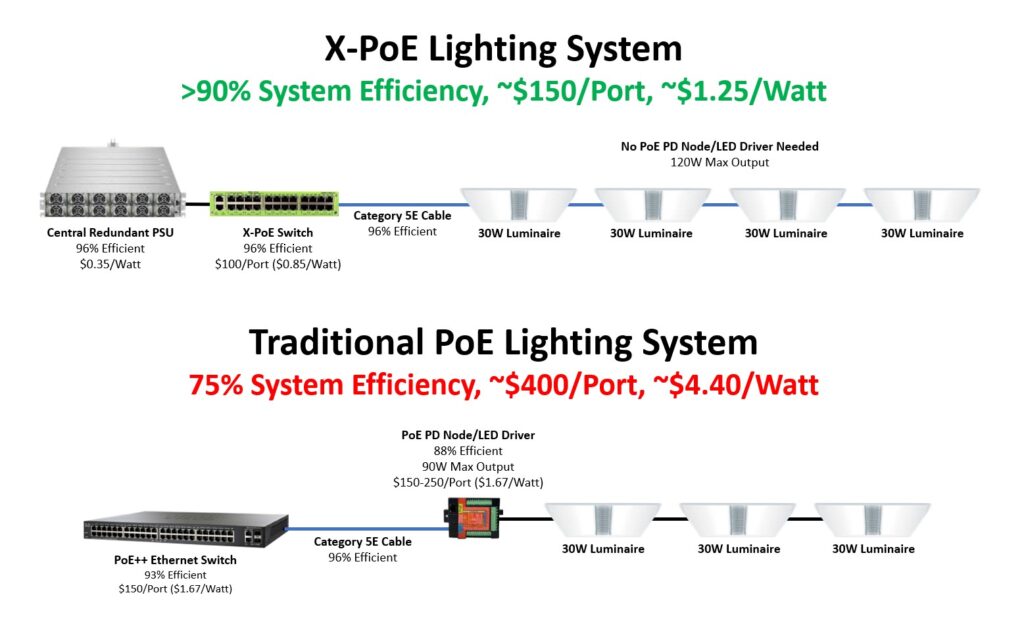First introduced in 2003, power over Ethernet (PoE) technology has advanced over the past two decades, gaining ground as a cost-effective means to power IT devices such as VoIP phones, Wi-Fi access points, surveillance cameras, and digital displays. With the ability to deliver power and data to connected devices over a twisted-pair Ethernet cable (e.g., Category 5e, 6, 6A), PoE technology eliminates the need for separate AC power circuits and provides significant material and labor savings. PoE’s low-voltage Class 2 wiring status does not require conduit in most environments, improves fire and electric shock safety, and enables installation by low-voltage technicians rather than requiring licensed electricians.
When the latest IEEE 802.3bt standard was introduced in 2018 with Type 3 PoE that delivers 60W and Type 4 PoE that delivers 90W of power, it opened the door for powering more devices, including LED lights. Despite the benefits, PoE technology has limitations that have hindered global PoE lighting adoption. That’s where extended PoE (X-PoE) technology comes in.
Traditional PoE Lighting Limitations
While traditional PoE technology has been pivotal in delivering power and bandwidth to networked devices, it has several limitations when applied to LED lighting systems. First, network cabling standards limit PoE distances to 100 meters. The 100-meter distance limitation is primarily due to the impact of length-dependent performance parameters on Ethernet data transmission, including insertion loss (i.e., signal loss), propagation delay (i.e., the amount of time it takes for a signal to reach the far end of a link), DC resistance, and signal-to-noise ratio that degrades with increased frequency and distance. However, unlike high-bandwidth Wi-Fi access points and other networked devices, LED lights require very little data. Yet, enterprise-grade managed PoE network switches are primarily about networking and bandwidth, making them overkill and far too expensive to power LED lights. Enterprise-grade PoE switches also have a maximum power budget for all ports, preventing the ability to achieve a full 90W on each port. Based on average costs, an enterprise-grade 48-port PoE network switch costs about $150 per port.
Traditional PoE costs are still too high to drive adoption even when using a single connected PoE lighting node to power multiple LED lights. PoE lighting nodes are powered devices (PDs) as defined by IEEE standards and require electronic components (e.g., chips, processors, microcontrollers, integrated circuits, RAM, etc.) for power negotiation, isolation of power and data, coding and decoding of data, network interface, and Ethernet communication—all of which is yet again overkill for lighting. The average cost of a PoE lighting node is around $300—a far cry from a traditional $10 AC/DC LED driver used in line voltage deployments. In fact, on a per-port basis, a PoE lighting node is the largest component cost of an entire PoE Lighting system.
All of the technology required in a PoE lighting node results in a relatively power-hungry device that loses efficiency—up to 20% in many cases. Like all PDs, PoE lighting nodes must also maintain a power signature even when not in use. While the IEEE 802.3bt standard added features for achieving lower nominal standby power, a PoE lighting node in standby mode can still consume up to 2W of power. This is in addition to the resistance of small-gauge Ethernet cables that also increase power loss. These inefficiencies are why Type 3 PoE that can deliver 60W allows only 51W at the PD and Type 4 PoE that can deliver 90W allows only 73W.
X-PoE to the Rescue
The cost of a PoE lighting system ultimately makes it a hard sell against line voltage installations in many situations—especially outside of the US where conduit isn’t required since that’s the biggest savings in US-based deployments. That ultimately led to the development of X-PoE technology—a groundbreaking extension to traditional PoE systems that significantly improves efficiency and lowers cost.
Like PoE, X-PoE technology delivers DC power over twisted-pair Ethernet cables. However, it eliminates the limitations of PoE by removing the need for any PoE device driver and associated electronics and standby power. Switches that use X-PoE technology are much simpler and more cost-effective than enterprise-class PoE switches. They do not have an integrated power supply unit (PSU) but receive DC power from any external 48V to 57V DC power supply, enabling higher power per port than PoE. They are also designed for lower bandwidth without unnecessary advanced networking management capabilities while still offering agnostic centralized lighting control. The result is a switch that improves efficiency, lowers costs and maintenance, and provides long-term reliability.
X-PoE switches are also backward compatible with standards-based PoE, including IEEE 802.3af (15W), 802.3at (30W), and 802.3bt (Type 3 60W and Type 4 90W), allowing for mixed IEEE PoE and X-PoE loads on a single switch. If an X-PoE switch detects a connected PoE device, it will deliver standards-based PoE, but if the signature resistor fails, the switch will look for an LED load in its X-PoE mode. If an LED load is discovered, the LED can be powered, dimmed, and controlled from the X-PoE switch without any PoE node or receiver while still transmitting Ethernet data over the twisted-pair cabling to support luminaires with integrated sensors.
X-PoE can deliver up to 120W of power per port via two pairs of a twisted-pair Ethernet cable (i.e., two 60-W channels) to about 300 meters. Depending on the LED luminaire wattage, one or more luminaires connected to an X-PoE port can be daisy-chained to utilize the per port power budget fully. The result is significantly improved efficiency and lower cost than traditional PoE lighting with the ability to deliver more power over greater distances, making DC-connected lighting systems competitive with even the most aggressive line voltage deployment.

To put the savings into perspective, the total installed lighting system cost for a 20,000-square-foot (ft²) warehouse ranges from $2.00 to $3.50/ft² for X-PoE depending on the power source versus $5.00 to $7.00/ft² for traditional PoE and $4.00 – $6.00/ft² for conventional line voltage with controls.
A Key Component of the AGILE-CORE™ System
X-PoE doesn’t just simplify and reduce the cost of deploying DC-connected lighting systems but also serves as an ideal solution within DC power distribution systems that are essential for commercial buildings to achieve net zero in line with state and federal regulations and ESG initiatives.
X-PoE switches are compatible with emerging Class 4 Fault-Managed Power systems such as VoltServer’s Digital Electricity (DE) technology that deliver DC power throughout a building from DC microgrids (click HERE to learn more about DC microgrids with DC power distribution). This compatibility allows Sinclair Digital to leverage X-PoE technology as a key component of its AGILE-CORE™ system that delivers the most energy-efficient and lowest-cost DC-connected lighting for today’s commercial buildings.
AGILE-CORE™ combines Fault Managed Power, PoE, and X-PoE technology to enable connected lighting without needing an external PoE node/device driver. It also provides connectivity and power for PoE-enabled IT devices such as surveillance cameras and Wi-Fi access points. Due to X-PoE’s power and distance capabilities, AGILE-CORE™ is especially ideal for lighting systems in hotels, warehouses, and big box stores. About 95% of LED luminaires on the market can work with X-PoE. As a value-added reseller with expertise in design/build installations, Sinclair Digital is also working with several lighting manufacturers to produce 25,000-lumen high-bay light fixtures that can be powered and controlled from a single X-PoE switch port, providing an efficiency of 218.2 lumens/W for a total system efficiency of approximately 95%.
With a packaged AGILE-CORE™ system for DC-connected lighting from Sinclair Digital, electrical contractors, lighting agents, and specifiers can gain a competitive edge and higher profit margins while helping their customers improve efficiency and lower operating costs. Get in touch with us today at info@sinclair-digital.com to discuss how we can help you deploy the most efficient, cost-effective DC-connected lighting systems with AGILE-CORE™.
